Looking to grow some veggies indoors? It’s not necessary to purchase a fancy indoor grow kit or to be stuck with just boring old mason jar sprouts. You also don’t need to clear out an entire room in order to produce your own food indoors. Without a lot of space or work, there are actually a lot of vegetables you can grow indoors with ease.
We’ll break down our best selections for year-round, simple-to-grow veggies in this guide. With the information in this guide, you’ll be able to prepare a fresh salad in the winter from the comfort of your own home!
1. Carrots
Carrots are a great vegetable to grow indoors. To start, they are perfect for container gardening due to their small size and shallow root system. You can grow a significant number of carrots in pots or planters if you have a little amount of room, thus enhancing your indoor gardening possibilities.
Just as well, indoor carrot cultivation gives you more control over their growing environment. Carrots like chilly climates, therefore growing them inside has the advantage of year-round consistency in temperature. You can foster the right environment for their development, assuring constant advancement and lowering the possibility of weather-related setbacks.
Farming carrots indoors also reduces the danger of pests and illnesses, which frequently afflict outside crops. Carrots can be successfully protected from typical garden pests like carrot rust flies or root-knot nematodes by being grown inside. This lessens the need for pesticides and makes growing organic food that’s free of chemicals possible.
The ease of always having a fresh supply of this healthy vegetable close at hand is another benefit of growing carrots indoors. Indoor gardening enables year-round growing, giving you a reliable supply of fresh carrots for your cooking requirements. Homegrown carrots plucked at the peak of freshness have an unrivaled crisp and sweet flavor.
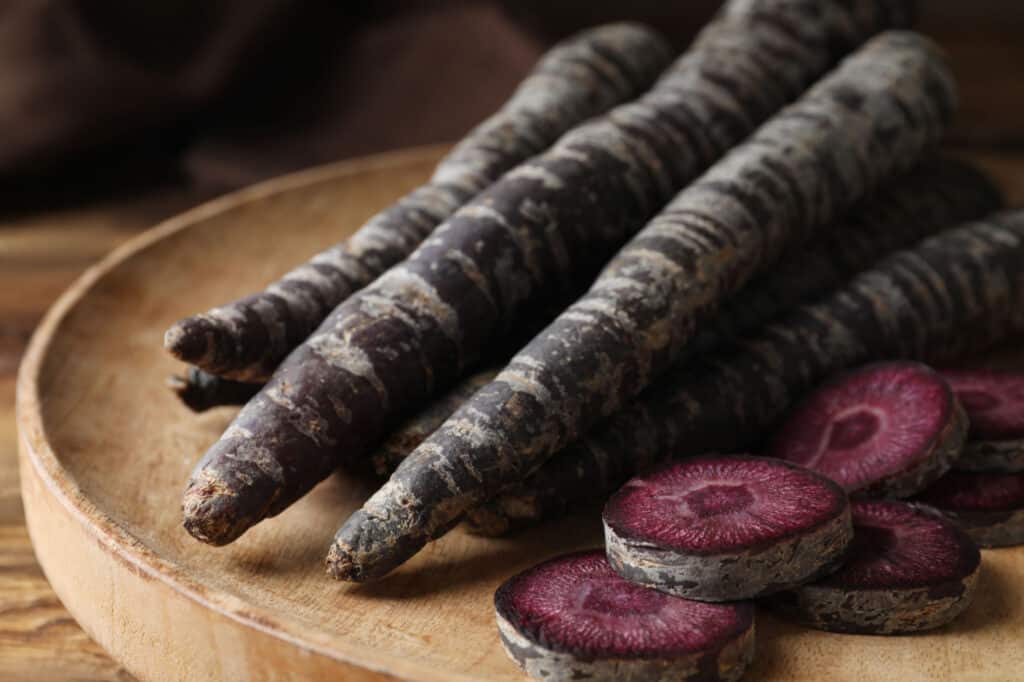
Carrots (pictured), whether purple or orange, are an easy vegetable to harvest indoors.
©New Africa/Shutterstock.com
2. Spinach
Due to its many health advantages and great track record for indoor growing, spinach is a great vegetable to grow indoors. This healthy leafy green can be grown year-round indoors, providing a fresh and continuous dose of vitamins and minerals.
One of the main factors contributing to spinach’s high appreciation for indoor growing is its small size and quick pace of growth. Even in very small or cramped settings, its petite and delicate leaves make it the perfect plant for container gardening. You can have a constant supply of fresh spinach all year long with routine picking.
Spinach is a nutritional powerhouse when it comes to health advantages, too. It promotes general health since it is loaded with vital nutrients including vitamins A, C, and K, as well as folate, iron, and calcium. Just as well, spinach contains several antioxidants that support a strong immune system by shielding the body from oxidative stress and inflammation.
Spinach is also well known for having a high fiber content that helps with digestion and fosters a healthy gut. It is a great option for managing weight and blood sugar levels because it is low in calories and carbs. Spinach has a wealth of vitamins and minerals that support cardiovascular health while also promoting strong bones, skin, and hair.
When you grow spinach inside, you have more control over the growth environment and can make sure it receives the right amount of light and heat. A clean and organic supply of this nutrient-dense crop can be made available via indoor farming, which lowers the danger of pests and disease.
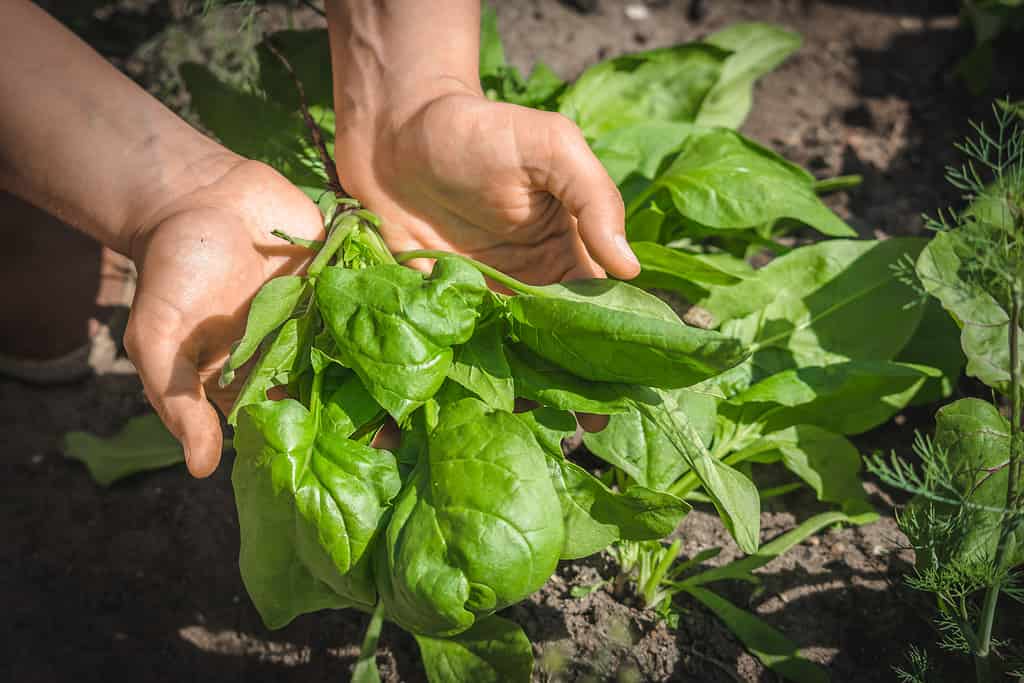
Spinach (pictured) can be harvested via pruning to avoid any mess indoors.
©alicja neumiler/Shutterstock.com
3. Green Onions
Green onions, sometimes referred to as scallions or spring onions, are a great vegetable to grow indoors since they have a number of advantages and are good for your health. This delicious species of onion can be easily grown indoors, providing a continuous supply of nutrient-rich, tasty, and fresh greens right in your own house.
Green onions’ small size and quick development are among the key factors that make them perfect for indoor planting. They are ideal for tiny indoor herb gardens and container gardening because they take up very little space. Green onions can also be harvested in just a matter of weeks, ensuring a year-round supply of fresh vegetables.
Green onions also have some surprising health benefits. They are abundant in potassium, folate, and vitamins A, C, and K, as well as other important nutrients. These nutrients promote a number of bodily functions, such as immune response, eyesight, and cardiovascular health. In addition to being low in calories, green onions also provide dietary fiber, which promotes good digestion.
Green onions are also renowned for their anti-inflammatory and antioxidant capabilities. These characteristics aid in scavenging free radicals, lowering inflammation, and possibly lowering the risk of chronic illnesses including heart disease and some forms of cancer.
Indoor green onion cultivation gives growers more control over environmental factors, including temperature and sun exposure. Any risk for toxins or pests that might make the soil their home is also removed, provided you purchase clean, fresh soil when planting your vegetables indoors.

Green onions (pictured) can be continually harvested by chopping off their largest leaves first.
©iStock.com/Dumitru Ochievschi
4. Peppers
When it comes to vegetables you can grow indoors, you can’t forget peppers! Peppers are a great vegetable to grow indoors since they have a ton of advantages for one’s health. They can also very easily be grown indoors, providing a steady supply of spicy, colorful, and fresh veggies right in the convenience of your own home.
Peppers are excellent for indoor growing for a number of reasons, including their small size and adaptability. They grow nicely in containers and can be grown in a variety of indoor environments, whether you select sweet bell peppers or hot chili peppers.
Peppers are a nutritious powerhouse that are rich in antioxidants and the vitamins A, C, and E. These nutrients boost immunological function, encourage healthy skin, and guard against cellular damage brought on by dangerous free radicals, all of which contribute to general health and well-being. Peppers also contain capsaicin, the substance that gives them their fiery taste but is also known to have painkilling and anti-inflammatory qualities.
Producing peppers indoors gives growers better control over environmental circumstances. Indoor pepper growers can provide the ideal exposure to sunlight and temperature regulation. Indoor gardening creates a healthier and pesticide-free growing environment by removing the risk of pests and illnesses that far too often harm outside crops.
Peppers are highly flexible in the kitchen, enhancing a variety of recipes with their brilliant colors, distinctive tastes, and nutritional value. Homegrown peppers give an unrivaled freshness and flavor to any dish, whether they are consumed raw in salads, roasted in stir-fries, or stuffed with meat for a savory supper.

Many different species of peppers (pictured) are well-suited for indoor growing.
©Brent Hofacker/Shutterstock.com
5. Herbs
Herbs are a fantastic option for indoor gardening since they provide a variety of advantages and health benefits. Most types of herbs are very well-suited to indoor environments, and tons of foodies out there grow them on their kitchen windowsill.
Herbs are perfect for growing indoors because of their versatility and small size. Herbs like basil, parsley, cilantro, and rosemary are excellent for even the tiniest interior areas since they can grow in small pots or containers.
Most herbs are prized for their culinary as well as health-related qualities. They are abundant in important vitamins, minerals, and antioxidants that promote general health. For instance, basil has antimicrobial qualities and is an excellent source of vitamin K. Vitamin C-rich parsley can help with digestion. Antioxidants found in rosemary have been linked to better cognitive and memory performance.
Most herbs can be grown inside since indoor gardening allows for better temperature control and sunshine exposure. Furthermore, having access to fresh herbs promotes culinary innovation and healthier cooking options. Herbs improve the flavor of food, avoiding the need for too much salt and other harmful additives. A more wholesome and balanced diet can also be supported by including herbs in meals. And who doesn’t love having access to fresh herbs?
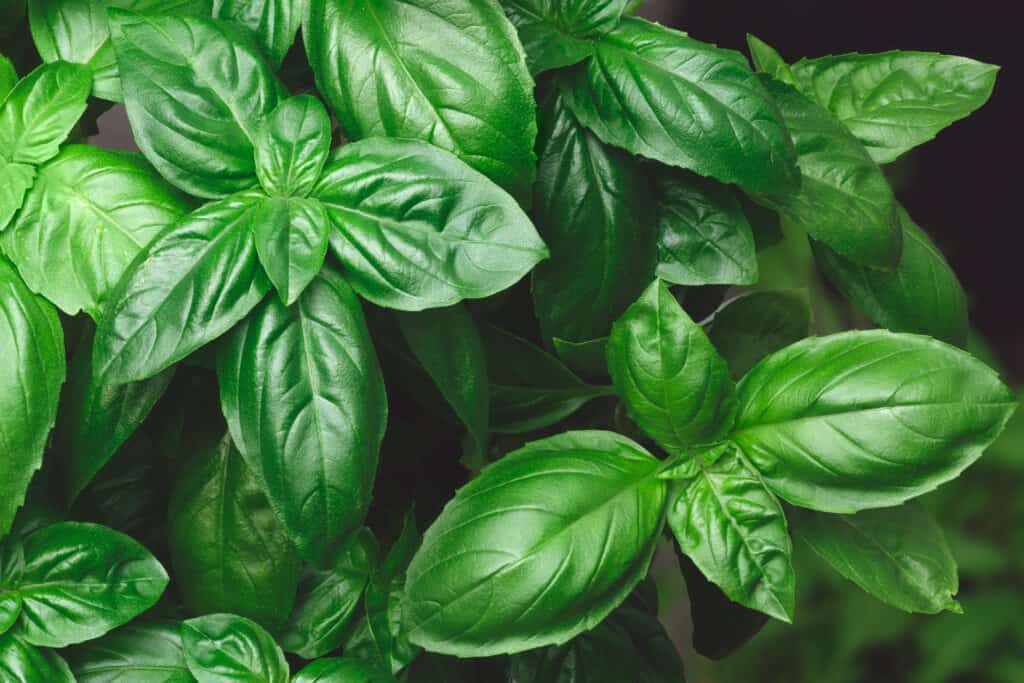
Herbs like basil (pictured) can be harvested regularly by pruning the largest leaves with clean shears.
©Hortimages/Shutterstock.com
6. Microgreens
Microgreens are a fantastic option for indoor gardening since they provide a plethora of advantages, culinary benefits, and health benefits. Growing microgreens indoors enables rapid and continual access to tasty, nutrient-dense greens in the convenience of your own home.
Microgreens’ small size and quick growth rate are among the main factors making them perfect for indoor growing. These little seedlings are perfect for small pots or trays since they are picked when they are just a few inches tall. Growers can take advantage of a plentiful harvest of colorful and delicate greens in just a few weeks.
Microgreens contain a remarkable amount of vitamins, minerals, and antioxidants. Even though they are smaller than their mature counterparts, they often have higher nutritional content. For example, microgreens like broccoli and radish are high in vitamins C and K, while microgreens like cilantro and basil are rich in antioxidants and vitamin A. Microgreens can help your body’s immune system, encourage healthy skin, and prevent cellular damage brought on by free radicals.
Microgreens bring a burst of freshness to salads, sandwiches, and other foods by offering a range of flavors and textures. Their adaptability enables inventive culinary research and the chance to try out various taste mashups. This is definitely one of the best vegetables you can grow indoors!

Microgreens like arugula (pictured) should be harvested when they are between one and three inches tall.
©vaivirga/Shutterstock.com
7. Peas
Peas are yet another great vegetable to grow indoors, which might be surprising to some. They can be grown inside with just a little bit of effort. These legumes are perfect for indoor growing because of their propensity of having a very compact growth habit. Numerous pea types, such as shrub or dwarf varieties, are suitable for container gardening. They are ideal for interior situations with little space since they take up less room than similar legumes.
Dietary fiber, vitamins C and K, as well as minerals like manganese and folate, are all found in abundance in peas. They offer a number of health advantages, including improving heart health, helping digestion, and strengthening the immune system. These legumes are a great option for vegetarians and vegans since they are a great source of plant-based protein.
Peas are also not only delicious but also adaptable in the kitchen. They can be eaten raw, steamed, or added to salads, stir-fries, and soups, among other dishes. Compared to store-bought equivalents, homegrown peas are more flavorful and nutritious as well.
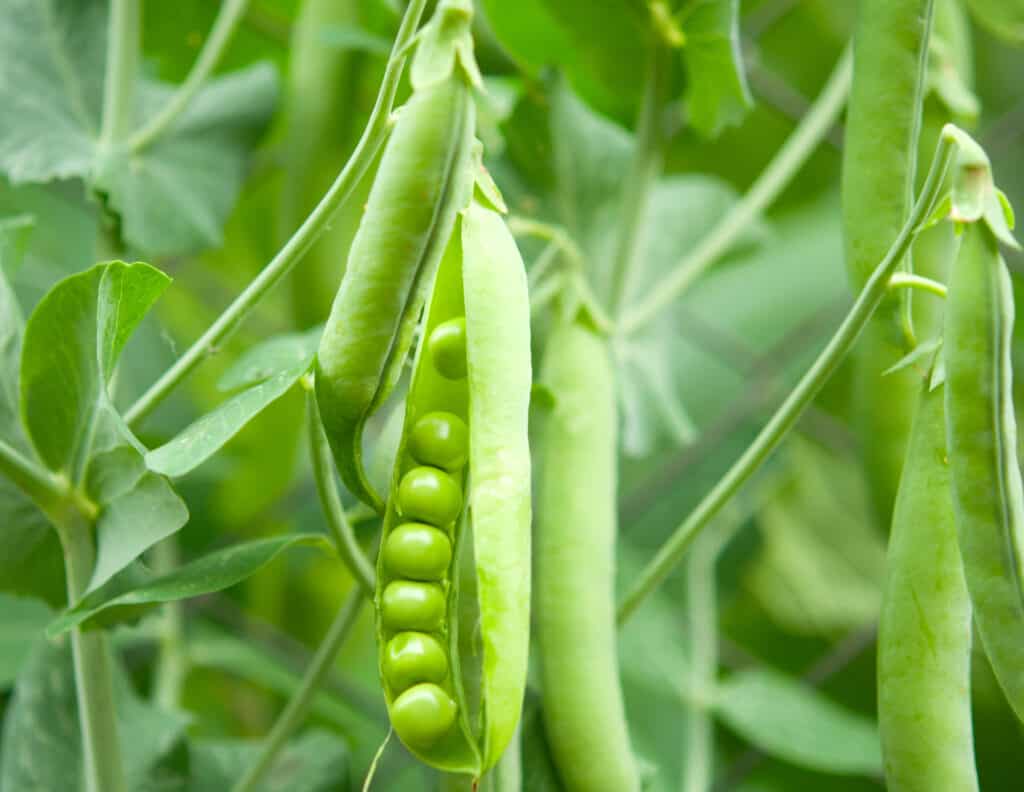
Most peas (pictured) can be harvested once their pods reach their largest size.
©iStock.com/ksena32
8. Tomatoes
Tomatoes are a great food to grow indoors since they have a lot of health advantages and don’t take a lot of effort to keep alive. These plants are often grown indoors to avoid winter and can provide a year-round supply of fresh, tasty fruits (yes, tomatoes are a fruit!) that are full of vital nutrients.
Tomatoes are excellent for indoor gardening for several reasons, one of which is their adaptability when it comes to container growing. Numerous compact or dwarf tomato types have been developed specifically for indoor cultivation, making them suited for confined settings. Indoor tomato plants can survive and yield a large crop with the right care and environment.
Tomatoes are renowned for having a wide range of nutrients. They are a great source of the antioxidant lycopene as well as the vitamins A, C, and K. Particularly lycopene has been linked to a number of health advantages, including lowering the risk of several malignancies and enhancing heart health. Most types of tomatoes also include fiber and potassium-rich nutrients that aid in digestion and maintain normal blood pressure.
Just as well, tomatoes produced at home have better flavor and texture than those purchased from a supermarket. It is gratifying and lovely to be able to pick ripe, juicy tomatoes fresh from the vine. Salads, sauces, and other culinary preparations all benefit from the variety of tomatoes, which provide food with a burst of freshness and nourishment.

Tomatoes (pictured) such as Roma and cherry tomatoes are great for indoor growing.
©AngieC333/Shutterstock.com
9. Potatoes
Growing potatoes indoors is a flexible and gratifying experience that rewards the grower with a variety of perks and health advantages. Potatoes can be grown indoors all year long and without a ton of work.
The adaptability of potatoes to container growing is one of the main reasons they are perfect for indoor gardening. Compact or dwarf potato cultivars are ideal for compact places since they are designed primarily for indoor cultivation. Indoor potato plants are capable of yielding a gratifying crop with the right care and attention.
Carbohydrates, dietary fiber, and important vitamins and minerals including vitamin C, potassium, and vitamin B6 are all found in abundance in potatoes. They help in brain growth and function, digestion, immunological support, and sustained energy production.
When potatoes are grown inside, growing conditions can be more precisely controlled, resulting in ideal light exposure, soil quality, and temperature. Potatoes grown inside are cleaner and pesticide-free, reducing the danger of pests, illnesses, and chemical contamination. Furthermore, compared to store-bought counterparts, potatoes produced at home have better flavor, texture, and diversity.
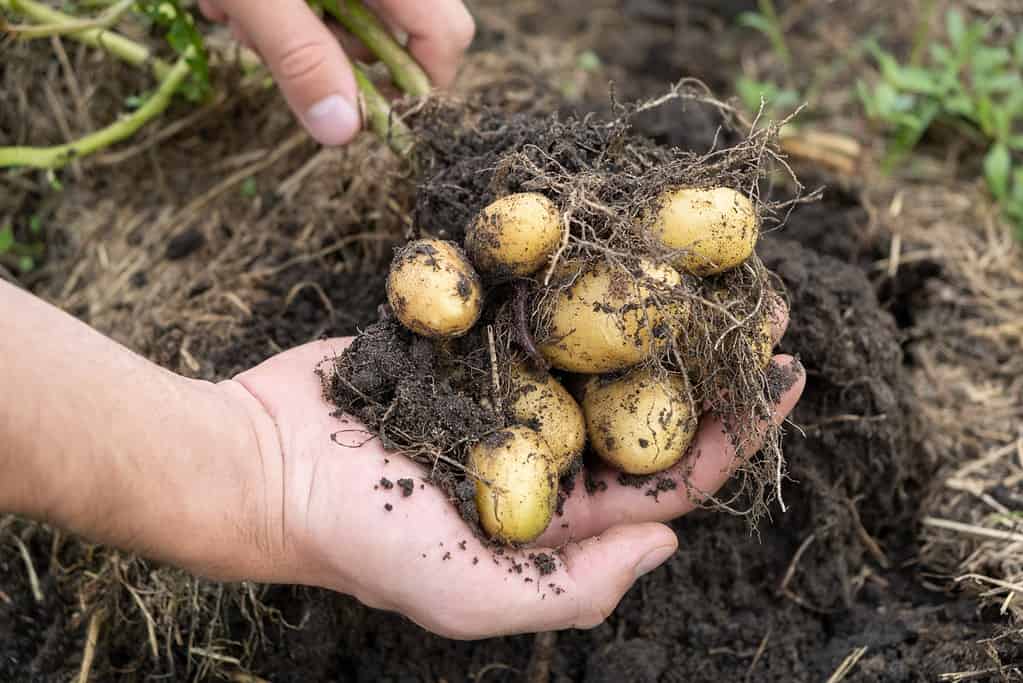
When harvesting potatoes (pictured) it would be wise to take your pot outside, as it can get messy.
©ArieStudio/Shutterstock.com
Some of the vegetables you can grow indoors on this list are a little surprising, aren’t they? With the great diversity of vegetables you can grow indoors, you definitely won’t have to worry about lacking fresh food in the wintertime. Happy gardening!
The photo featured at the top of this post is © 5 second Studio/Shutterstock.com
Thank you for reading! Have some feedback for us? Contact the AZ Animals editorial team.






